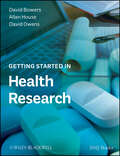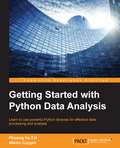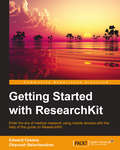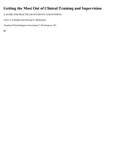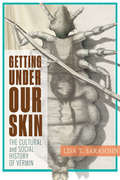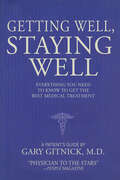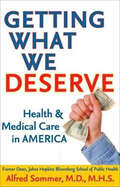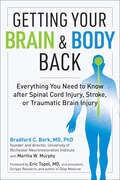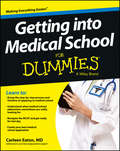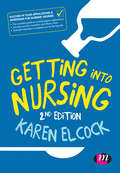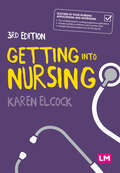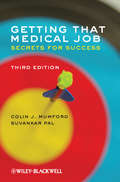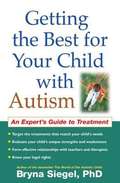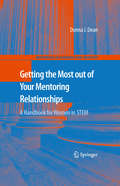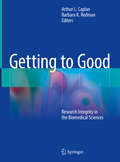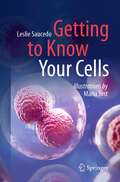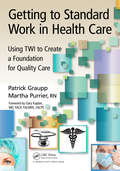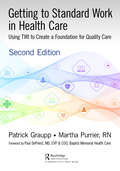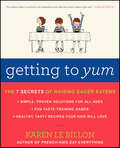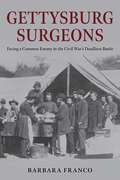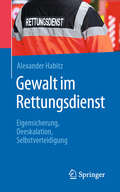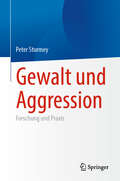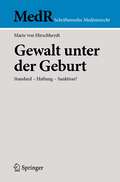- Table View
- List View
Getting Started in Health Research
by David Owens David Bowers Allan HouseBy the time you've read this book, you'll be ready to design your own research project Not everyone in clinical research is a scientific investigator. In fact, a large proportion of health professionals undertaking a research project are working in clinical care, as junior doctors, nurses or allied health professionals. For them a book that begins with the basics of study design and takes them through all the stages to data collection, analysis, and submission for publication is vital. Getting Started in Health Research is the answer. It provides fundamental information on: Framing the research question Performing the literature search Choosing the study design Collecting data Getting funding Recruiting participants Writing your paper Lively case studies provide a continuous narrative, addressing the pitfalls and problems that can occur. Calling upon their vast experience of teaching health research methodology, these authors have turned a seemingly daunting task into a challenging and enjoyable prospect. The companion of Understanding Clinical Papers www. wiley. com/buy/9780470091302 Reviews of Understanding Clinical Papers ". . . an excellent basis for all who intend to write scientific texts as well as those reading, evaluating, and trying to understand the results. . . " Clinical Chemistry, May 2007 "What makes this book unique is that each point presented is illustrated with excerpts from actual papers, often three or four per chapter. . . this is a very effective teaching device. " Journal of the American Medical Association, December 26, 2006 "What strikes the reader . . . straight away is clarity . . . promises to become a recommended text for undergraduate and postgraduate courses. " Journal of Tropical Pediatrics, September 2006 "This book should be an essential addition to the personal libraries of all health care workers . . . " Oncology, 2002
Getting Started with Python Data Analysis
by Phuong VothihongIf you are a Python developer who wants to get started with data analysis and you need a quick introductory guide to the python data analysis libraries, then this book is for you.
Getting Started with ResearchKit
by Dhanush Balachandran Edward CessnaEnter the era of medical research using mobile devices with the help of this guide on ResearchKit! About This Book * Create a simple clinical research app using most aspects of ResearchKit * Build a simple survey with various data types with the results printed on the screen. * A step-by-step guide introducing Apple's ResearchKit and techniques to incorporate it into various apps. Who This Book Is For This book is aimed at medical researchers with basic iOS coding knowledge and iOS developers looking to create clinical research apps. What You Will Learn * Learn to create customized consent form * Get introduced to two backend services: a simple backend server using Sinatra and Sage Bridge * Build a custom task (a conditional survey example) and a navigable task * Get an Overview of ResearchKit's open source repository and App Core * Interaction with the hardware of the device including the gyro and the motion sensors * Learn the basics of this revolutionary technology * Get introduced to the barebones app and learn to write your first code In Detail ResearchKit is an open source software development framework from Apple that lets you easily create mobile applications for clinical research studies. ResearchKit provides you the ability to orchestrate the administration of tasks and recording of the results. ResearchKit provides tasks in order to perform informed consent, active tasks, and surveys. Starting with the basics of the ResearchKit framework, this books walks you through the steps of creating iOS applications that could serve as the basis of a clinical research mobile app. This book will introduce readers to ResearchKit and how to turn your iPhone into into a clinical research tool. The book will start off by installing and building the research framework in line with the researcher's needs; during this, the reader will learn to embed ResearchKit in the application and create a small task. After this, the book will go a little deeper into creating modules for surveys, consents, and so on. The book will also cover the various aspects of privacy and security with regard to participant data, and how to build dashboards for visualizing medical data and results in line with the researcher's requirements: data backends, JSON serialization and deserialization, and so on. Readers will be able to fully utilize ResearchKit for medical research, will be able to get more and more patients to participate in their surveys, and will gain insights from the surveys using the dashboards created. Style and approach A hands-on guide with ample screenshots for you to follow and learn about ResearchKit. Each topic is explained sequentially and placed in context so that you can get a better understanding of every step in the process of creating clinical research apps.
Getting The Most Out Of Clinical Training And Supervision: A Guide To Practicum Students And Interns
by Carol A. Falender Edward ShafranskeClinical training is challenging for supervisees, many of whom are unsure how to navigate the supervisory process and effectively build clinical skills and professional competence. While research and book-length texts on effective supervision have proliferated, these are typically directed towards supervisors and clinical educators.
Getting Under Our Skin: The Cultural and Social History of Vermin
by Lisa T. SarasohnHow vermin went from being part of everyone's life to a mark of disease, filth, and lower status.For most of our time on this planet, vermin were considered humanity's common inheritance. Fleas, lice, bedbugs, and rats were universal scourges, as pervasive as hunger or cold, at home in both palaces and hovels. But with the spread of microscopic close-ups of these creatures, the beginnings of sanitary standards, and the rising belief that cleanliness equaled class, vermin began to provide a way to scratch a different itch: the need to feel superior, and to justify the exploitation of those pronounced ethnically—and entomologically—inferior. In Getting Under Our Skin, Lisa T. Sarasohn tells the fascinating story of how vermin came to signify the individuals and classes that society impugns and ostracizes. How did these creatures go from annoyance to social stigma? And how did people thought verminous become considered almost a species of vermin themselves? Focusing on Great Britain and North America, Sarasohn explains how the label "vermin" makes dehumanization and violence possible. She describes how Cromwellians in Ireland and US cavalry on the American frontier both justified slaughter by warning "Nits grow into lice." Nazis not only labeled Jews as vermin, they used insecticides in the gas chambers to kill them during the Holocaust.Concentrating on the insects living in our bodies, clothes, and beds, Sarasohn also looks at rats and their social impact. Besides their powerful symbolic status in all cultures, rats' endurance challenges all human pretentions. From eighteenth-century London merchants anointing their carved bedsteads with roasted cat to repel bedbugs to modern-day hedge fund managers hoping neighbors won't notice exterminators in their penthouses, the studies in this book reveal that vermin continue to fuel our prejudices and threaten our status. Getting Under Our Skin will appeal to cultural historians, naturalists, and to anyone who has ever scratched—and then gazed in horror.
Getting Well, Staying Well: Everything You Need to Know to Get the Best Medical Treatment
by Gary GitnickLet' s face it: the healthcare system is a total mess. It' s a confusing labyrinth of red tape, restrictions, and dysfunction, and it only seems to be getting worse. In Getting Well, Staying Well, Dr. Gary Gitnick breaks down the basics of healthcare in an easy-to-use guide that enables you to obtain the high-quality healthcare that you deserve. Covering everything from how to find a great doctor to navigating the emergency room, from reducing the cost of your medication to correcting errors in your medical records, Dr. Gitnick proves the roadmap you need to get the most out of our broken healthcare system.
Getting What We Deserve: Health & Medical Care in America
by MD Alfred SommerA leading public health expert presents a frank diagnosis of the U.S. healthcare system and the role we all play in our own wellness.Through his groundbreaking work in clinical medicine and public health, Alfred Sommer has saved countless lives. But doctors can only do so much. In this blunt assessment of the American healthcare system, Sommer argues that human behavior has a stronger effect on wellness than almost any other factor.Despite exciting advances in genomic research and cutting-edge medicine, the best defense against most illness remains simple, low-tech habits such as proper hand washing, regular exercise, a balanced diet, and not smoking. But rather than focusing on wellness, many Americans would rather wait for medical science to cure them once they become sick. Sommer argues that this overconfidence in medical technology comes at a terrible cost.The benefits of almost all newly developed treatments are marginal, while their costs are high. The United States spends nearly twice as much on health care as the rest of the developed world, yet has higher infant mortality rates and shorter longevity than most nations. In this engaging and well-informed study, Sommer makes a persuasive chase for changing the way Americans approach healthcare.
Getting What We Deserve: Health and Medical Care in America
by Alfred SommerOne of America's leading public health experts finds a host of ills in this country's health care system:• The United States spends nearly twice as much on health care as the rest of the developed world, yet has higher infant mortality rates and shorter longevity than most nations.• We have access to many different drugs that accomplish the same end at varying costs, and nearly all are cheaper abroad.• Our life span had doubled over the past century before we developed effective drugs to treat most diseases or even considered altering the human genome.• The benefits of almost all newly developed treatments are marginal, while their costs are high.In his blunt assessment of the state of public health in America, Alfred Sommer argues that human behavior has a stronger effect on wellness than almost any other factor.Despite exciting advances in genomic research and cutting-edge medicine, Sommer explains, most illness can be avoided or managed with simple, low-tech habits such as proper hand washing, regular exercise, a balanced diet, and not smoking. But, as he also shows, this is easier said than done.Sommer finds that our fascination with medical advances sometimes keeps us from taking responsibility for our individual well-being. Instead of focusing on prevention, we wait for medical science to cure us once we become sick.Humorous, sometimes acerbic, and always well informed, Sommer's thought-provoking book will change the way you look at health care in America.
Getting Your Brain and Body Back: Everything You Need To Know After Spinal Cord Injury, Stroke, Or Traumatic Brain Injury
by Bradford C. BerkMake the fullest possible recovery after neurological injury with this definitive guide—by a doctor and spinal cord injury survivor who’s been there After an accident that left him permanently paralyzed over ten years ago, Dr. Bradford Berk made it his mission to help others recover from acute neurological injury (ANI). As the founder and director of the University of Rochester Neurorestoration Institute, he brings his abundant experience in working with patients and making his own ongoing recovery to Getting Your Brain and Body Back, the most up-to-date guide for survivors of spinal cord injury (SCI), stroke, and traumatic brain injury (TBI). Each of these acute neurological injuries can result in similar physical and psychological challenges and require similar treatments, medications, and assistive devices. Getting Your Brain and Body Back offers comprehensive, reassuring guidance for your every concern: How to deal with grief and trauma in the aftermath of accident or injury—and build resilience as you find your way forward What adaptive devices—for bathing, dining, mobility, and more—will help you enjoy life to the utmost How to prevent and treat secondary health problems of every kind, such as heart, skin, and bladder troubles—sexual health included! Therapeutic approaches from both Western and Eastern medicine to consider for maximum healing and pain relief Dr. Berk’s candid advice on medical treatment and daily living—plus insights from the brightest minds in the field—will help get you or your loved one back to life.
Getting into Medical School For Dummies
by Carleen EatonYour plain-English guide to getting into the medical school of your dreamsGetting accepted to medical school is a long and rigorous process and many students find they need help. If you're one of these students, Getting into Medical School For Dummies is the perfect tool to help you through the process and realize your dream.By providing you with concise information about preparing for and applying to medical school, Getting into Medical School For Dummies prepares you for the application process. Written by an industry expert, it gives you a distinct advantage in the competitive medical school admissions process, preparing you for every step and helping you create your best application.Takes you through the often-overwhelming process of applying to medical school Explains what medical schools and admissions committees are really looking forProvides plain-English explanations of complicated medical school admissions processesIf you're one of the over 40,000 students who apply to medical school each year and need help sorting through the admissions schedule, writing statements of intent, and preparing to take the MCAT, Getting Into Medical School For Dummies has you covered!
Getting into Nursing (Transforming Nursing Practice)
by Karen ElcockNursing is the one of the most popular degrees in the UK, with nearly 200,000 applicants every year. Competition for places is tough, and it is essential to stand out from the crowd in order to get a place. This book helps potential nursing students succeed in getting into nursing. It gives practical help on the application process: filling out application forms, passing numeracy and literacy tests and succeeding at interviews. It also explains what nurses do, what personal qualities are needed and what is involved in nursing training, so applicants can decide whether nursing is really for them.
Getting into Nursing: A complete guide to applications, interviews and what it takes to be a nurse (Transforming Nursing Practice Series)
by Karen ElcockConsidering a career in nursing and want to understand what is involved? Ready to take the plunge and looking for advice on choosing a course and succeeding in your application? This book has been written for you. Why do you need this book? · Learn what it is like to be a nurse today and what you’ll need to get there, from personal qualities and values to practical work experience and entry requirements · Understand the different routes into nursing and how to choose the right field · Practical advice and activities help you to write a compelling application and practise for your interview · Top tips from students, lecturers and nurses provide an insight into what to expect from the process, and how to avoid common pitfalls
Getting into Nursing: A complete guide to applications, interviews and what it takes to be a nurse (Transforming Nursing Practice Series)
by Karen ElcockConsidering a career in nursing and want to understand what is involved? Ready to take the plunge and looking for advice on choosing a course and succeeding in your application? This book has been written for you. Why do you need this book? · Learn what it is like to be a nurse today and what you’ll need to get there, from personal qualities and values to practical work experience and entry requirements · Understand the different routes into nursing and how to choose the right field · Practical advice and activities help you to write a compelling application and practise for your interview · Top tips from students, lecturers and nurses provide an insight into what to expect from the process, and how to avoid common pitfalls
Getting that Medical Job: Secrets for Success
by Suvankar Pal Colin J. MumfordConfused and stressed by the latest round of Foundation Programme recruitment? Looking to bag that Specialty Training position? Applying for your first consultant’s post? This fully updated short guide covers recruitment at each step of the medical career, and helps you plan an effective strategy to get the job you want. The authors advise on the basics from choosing your ideal specialty, preparing a strong CV, and what to do to get shortlisted, through the application process, and the interview itself. New features include: Chapters tackling online application for the Foundation Programme, and the new structured interview in Specialty Training recruitment How to deal with the academic interview Advice on how to explain time out from training Real examples of successful and unsuccessful answers to interview questions Step-by-step key points to consider when working on your own application With advice on successfully moving and settling into your new medical job, this is the ideal aid for medical students applying for Foundation Programme training, recently qualified junior doctors applying for Specialty Training, and those applying for their first consultant post.
Getting the Best for Your Child with Autism
by Bryna SiegelAs the parent of a child with an autism spectrum disorder, you need an informed, caring advocate who can deftly guide you through the complex maze of treatment options. In this empowering resource, bestselling author Bryna Siegel--one of the world's leading authorities on the disorder--helps you zero in on proven strategies and tailor them to fit your child's unique needs. Like no other book, Getting the Best for Your Child with Autism shows how to get an accurate assessment of your child's strengths and weaknesses so you can develop a plan of action suited to his or her individual learning style, interests, verbal abilities, and social skills. You'll learn what services you're entitled to, how to determine what's right for your family, and ways to work effectively with doctors and school professionals. With Dr. Siegel as your ally, you can help your child learn and grow.
Getting the Most out of Your Mentoring Relationships
by Donna J. DeanTraditionally, scientific research in all disciplines has demanded single-mindedness, exclusive devotion, and aggressive self-promotion. The image of the scientist in the laboratory at all hours of the night and weekend is not far from the reality sometimes demanded. Because of the structure of the science, technology, engineering, and mathematics (STEM) curricula and workplace environment, women often work up to 80 hours per week with little time for outside pursuits - let alone extracurricular reading. Yet, precisely because of these demands, it is imperative that they build solid mentoring relationships. This handbook aims to provide a quick, yet structured guide to mentoring including finding the right mentors, being a good mentee, and making the most out of today's diverse mentoring environments. A handy resource guide will be included for quick reference.
Getting to Good: Research Integrity In The Biomedical Sciences
by Barbara K. Redman Arthur L. CaplanThis book represents the first comprehensive, gold standard reader on research integrity in the biomedical sciences. Now more than ever, the responsible conduct of research (RCR) has become critically important as new technologies affect research practices in both positive and negative ways. Since learning to do science and practicing it brings researchers into contact with a vast array of ethical issues, it is critical to know the standards and how they are evolving. Indeed, research integrity requires scientists at all levels to operate ethically in a system that supports ethical practice. This unique, foundational text covers all the relevant areas -- subject protection, research misconduct and conflict of interest as well as newly quantified concerns about research bias and non-reproducibility, as well as other unique issues. Developed by renowned experts, this compelling title discusses the full range of practices and policies that should support research that is honestly produced and disseminated. It also specifically incorporates topics noted by the National Institutes of Health as essential and required for training in RCR. Getting to Good – Research Integrity in the Biomedical Sciences is a major contribution to the literature on bioethics and will serve as an invaluable resource for all researchers, students, administrators and professionals interested in research ethics and integrity.
Getting to Know Your Cells
by Leslie SaucedoThis book acts as a field-guide for human cells. The book’s unique structure first separates cells by what makes them distinctive, and then examines the essential “tools and parts” needed for both the cells’ specialized function, and also the basic mechanisms that are shared with most other cells. The chapters highlight interactions between multiple cell types, exploring areas such as immunology and cancer to exemplify the complex coordination of cells, as well as the manipulation of normal cell interactions. This book works as a companion reference for an academic text in cell and molecular science, and will be of general interest to anyone who wants to learn more about how cells work and interact.
Getting to Standard Work in Health Care: Using TWI to Create a Foundation for Quality Care
by Patrick Graupp Martha PurrierAddressing the challenges involved in achieving standard work in health care, Getting to Standard Work in Health Care: Using TWI to Create a Foundation for Quality Care describes how to incorporate the most widely used Training Within Industry (TWI) method, the Job Instruction (JI) training module, to facilitate performance excellence and boost emp
Getting to Standard Work in Health Care: Using TWI to Create a Foundation for Quality Care
by Patrick Graupp Martha PurrierAddressing the challenges involved in achieving standard work in health care, Getting to Standard Work in Health Care, 2nd Edition describes how to incorporate the Training Within Industry (TWI) methods of Job Instruction (JI), Job Relations (JR) and Job Methods (JM) to facilitate performance excellence and boost employee morale in a health care organization. It not only examines the TWI methodologies but also explains how this program is as vital and applicable in today’s health care environment as it was when it was developed to train replacements of an industrial workforce off to fight in WWII. Placing this methodology squarely within the health care paradigm, the book uses easy-to-understanding terminology to describe how these methods can make all the difference in the delivery of quality health care. Supplying the foundation for successful Lean practice in health care, it clearly defines the role of standard work and leadership skills in relation to Lean health care. The updated text includes new case studies of current TWI usage in health care that demonstrates how to successfully roll out a sustainable TWI initiative. All new chapters on Job Relations and Job Methods give insight into the full scope of TWI skills development. Including examples of TWI application during the Covid pandemic, the book provides readers with the understanding of how to use these time-tested methodologies to improve training, increase engagement, and deliver continuous improvement in your organization.
Getting to YUM: The 7 Secrets of Raising Eager Eaters
by Karen Le BillonFrom the author of the popular French Kids Eat Everything, a simple, easy and surprisingly fun way to change dinnertime reactions from YUCK to YUM.Are mealtimes with your kids a source of frustration? Ever wonder how on earth to get them to eat the recommended 5 servings of fruits and veggies per day (or even per week)?Getting to YUM is a practical and engaging guide for parents eager to get past their children's food resistance—or avoid it altogether. It introduces 7 Secrets of Raising Eager Eaters (Secret 1: Teach your child to eat, just like you teach them to read! or Secret 6: Teach me to do it myself: kid participation is every parent's secret weapon).Karen Le Billon, author of French Kids Eat Everything, coaches readers through the process of taste training, including strategies, games and experiments that will encourage even reluctant eaters to branch out. Over 100 delicious, kid-tested, age-appropriate recipes lead families step-by-step through the process of "learning to love new foods," enabling kids to really enjoy the foods we know they should be eating.Wise and compelling, Getting to YUM is grounded in revolutionary new research on the science of taste. Packed full of observations from real-life families, it provides everything parents need to transform their children—from babies to toddlers to teens—into good eaters for life.
Gettysburg Surgeons: Facing a Common Enemy in the Civil War's Deadliest Battle
by Barbara FrancoIn the bloodiest battle of the Civil War, a thousand surgeons faced an unprecedented medical catastrophe: 25,000 wounded soldiers needing immediate care with only primitive tools and their own determination to save lives. At Gettysburg's makeshift hospitals—set up in barns, churches, and blood-soaked fields—military and civilian surgeons from both North and South worked around the clock performing life-saving operations under fire. Drawing from a decade of meticulous research, historian Barbara Franco reveals how these courageous medical professionals revolutionized battlefield medicine and established principles still saving lives today. Through vivid accounts and previously untold stories, readers will discover: How surgeons improvised new techniques that became standard trauma procedures The harrowing reality of Civil War field hospitals during the three days of battle How lessons learned at Gettysburg transformed American military medicine The lasting impact on modern emergency and disaster response From the founding director of the Gettysburg Seminary Ridge Museum comes an unforgettable narrative of medicine, courage, and innovation that speaks to both history enthusiasts and medical professionals. This definitive account shows how the medical crisis at Gettysburg continues to influence how we treat mass casualties and train combat medics today.
Gewalt im Rettungsdienst: Eigensicherung, Deeskalation, Selbstverteidigung
by Alexander HabitzMitarbeiter von Rettungsdienstorganisationen sind heute zunehmend Gewalt und Aggressionen ausgesetzt. Wie es gelingt, gefährliche Einsatzsituationen zu entschärfen oder sogar ganz zu verhindern, zeigt das vorliegende Werk. Dargestellt werden einfache, verbale Deeskalationsstrategien sowie leicht erlernbare Techniken der Eigensicherung und Selbstverteidigung. Zahlreiche Abbildungen verdeutlichen das optimale Vorgehen. Das Buch wendet sich an alle Rettungsdienstmitarbeiter, die sich für brenzlige Situation wappnen möchten, aber auch Feuerwehrleuten, Mitarbeitern von Ordnungsdiensten und Security Diensten bietet das Werk wertvolle Tipps für schwierige Situationen.
Gewalt und Aggression: Forschung und Praxis
by Peter SturmeyDieses Buch bietet einen prägnanten und umfassenden Überblick über vielfältige Themen im Bereich von Gewalt und Aggression. Es verwendet einen funktionalen Ansatz, der die evolutionären, kulturellen und operanten Faktoren von Gewalt und Aggression darstellt. Das Buch zeigt Entstehungsfaktoren verschiedener Formen von Gewalt und Aggression, erläutert Epidemiologie und Risikofaktoren, beschreibt biologische, kulturelle und individuelle Ursachen und diskutiert individuelle sowie gesellschaftliche Möglichkeiten von Prävention und Therapie. Wichtige Themen umfassen: Epidemiologie von Gewalt und Aggression Biologische und soziale Ursachen von Gewalt und Aggression Kulturelle Interventionen, Psychotherapien und individuelle biologische Interventionen Die Auswirkungen von Gewalt und Aggression in besonderen Bevölkerungsgruppen Gewalt und Aggression: Forschung und Praxis ist eine unverzichtbare Ressource für Forscher, Akademiker sowie Studierende der höheren Semester in forensischer Psychologie Kriminologie/Strafjustiz, Entwicklungspsychologie, Psychotherapie/Beratung, Psychiatrie, öffentlichen Gesundheitseinrichtungen, Sozialarbeit, Bildungspolitik und -wissenschaften, Gesundheitspsychologie, Pflege sowie Verhaltenstherapie und Rehabilitation.
Gewalt unter der Geburt: Standard - Haftung - Sanktion? (MedR Schriftenreihe Medizinrecht)
by Marie von HirschheydtDieses Buch schließt eine Lücke auf dem Gebiet der rechtlichen Auseinandersetzung im Bereich der Geburtshilfe und Geburtsmedizin. Hierbei eignet es sich als zivilrechtliches Nachschlagewerk des geburtshelferischen Wissens sowohl für Rechtsanwender als auch für alle an einer Geburt beteiligten Personen und betritt hierbei Neuland in Bezug auf die rechtliche Beurteilung von geburtshelferischen Interventionen. Unter Berücksichtigung der zivilrechtlichen, strafrechtlichen und rechtshistorischen Aspekte verdeutlicht dieses Werk die Notwendigkeit der intensiven und offenen Auseinandersetzung zwischen Recht und Medizin. Neben den juristisch möglichen Konsequenzen zeigt die Arbeit auch Lösungsansätze auf, wie die Geburtssituation für alle Beteiligten positiver wahrgenommen werden kann und eine Aufarbeitung mit schwierigen Geburten und somit Verbesserung der derzeitigen Situation in der Geburtshilfe bzw. Geburtsmedizin gelingen kann.
